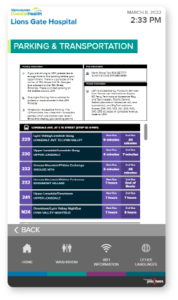Healthcare facilities are always in pursuit of ways to enhance the patient, visitor, and staff experience. After all, anything that contributes to a more inclusive, efficient, and stress-free environment leads to better outcomes for all. Technology has a central part to play in these objectives, and here’s where unlocking the full power of a digital information hub can lead the way.
 “The digital directories you find in a hospital have come a long way since the days of static listings and occasional messaging,” says Scot Martin, President and CEO of youRhere. “Today, these signs – or as we now call them, digital information hubs –can do much more to make a healthcare environment more welcoming and accessible.”
“The digital directories you find in a hospital have come a long way since the days of static listings and occasional messaging,” says Scot Martin, President and CEO of youRhere. “Today, these signs – or as we now call them, digital information hubs –can do much more to make a healthcare environment more welcoming and accessible.”
That’s not to say digital information hubs aren’t still used to help hospital visitors get to where they’re going. Now, however, digital information hubs within a healthcare facility can be far more interactive and information-rich while offering a suite of services that enrich everyone’s experience.
Promoting accessibility
Hospitals must serve all segments of society, including those with disabilities or people who don’t speak English or French as their first language. And in an environment where accessibility is fundamental to care, having digital information hubs that can be read and understood by all demographics is key.
 “In any healthcare setting, accessibility must be emphasized in every sense of the word,” says Martin. “That not only means including ramps and elevators for people with mobility challenges, but having digital information hubs that display information at appropriate heights, languages, and with audio options for the visually impaired.”
“In any healthcare setting, accessibility must be emphasized in every sense of the word,” says Martin. “That not only means including ramps and elevators for people with mobility challenges, but having digital information hubs that display information at appropriate heights, languages, and with audio options for the visually impaired.”
These hubs can also make a hospital more accessible by keeping patients and visitors updated on what’s happening within the facility. Here again, notes Martin, they offer an effective and eye-catching way to communicate hospital announcements and initiatives: “Say you have a hospital fundraiser going on, or an upcoming event or initiative you want to get people excited about. You can use that big, bright screen in the lobby to bring attention to those messages and drive engagement.”
A helping hand
Initially, digital directories were primarily used to help hospital patients, guests, and visitors get to where they were going quickly and conveniently. That remains true, but modern digital hubs can be much more interactive than before, offering key hospital information, directions to onsite stores and services, and helpful videos and images at the tap of the screen.
“Going to a hospital is often a stressful experience, both for the person who is there for treatment and for their friends or family members coming to visit. So anything you can do to make that environment more welcoming and less of a headache to navigate makes a big impact,” says Martin.
 For instance, he adds, one of the most helpful services a modern digital information hub can provide is simply helping people get to and from the building: “A lot of the clients that use our digital information hubs are offering live transit feeds that help their patients and visitors get to where they’re going and then back home again safely and efficiently. For instance, say you have someone leaving a visit or appointment; they can hit a button on the screen and find out exactly when the next bus to their destination is coming, how close they are to other transportation hubs, or even get information for a ride-share.”
For instance, he adds, one of the most helpful services a modern digital information hub can provide is simply helping people get to and from the building: “A lot of the clients that use our digital information hubs are offering live transit feeds that help their patients and visitors get to where they’re going and then back home again safely and efficiently. For instance, say you have someone leaving a visit or appointment; they can hit a button on the screen and find out exactly when the next bus to their destination is coming, how close they are to other transportation hubs, or even get information for a ride-share.”
“Not only does that make using transit easy and convenient,” Martin continues, “It also means people don’t have to wait outside in the rain or snow for their ride. They know exactly when it’s going to be there.”
Upholding health and safety
Digital information hubs have been invaluable in enforcing health and safety protocols and educating the public on best health and safety practices. This was true during the pandemic and remains so as healthcare facilities strive for clean, hygienic, and comfortable environments.
 It’s also important that real-time information is critical in times of emergency. Here, again, is where digital information hubs can display essential safety information when needed most. “Many healthcare facilities are tying their signage into their building for emergency systems,” says Martin, explaining.
It’s also important that real-time information is critical in times of emergency. Here, again, is where digital information hubs can display essential safety information when needed most. “Many healthcare facilities are tying their signage into their building for emergency systems,” says Martin, explaining.
“If a disaster occurs and they need to evacuate people quickly, those signs will display critical emergency information like where to go, what to do, and when it’s safe to return again.”
Championing sustainability
Sustainability is fast becoming a priority for the healthcare community. To that end, many of youRhere’s clients are leveraging their digital information hubs to demonstrate how they’re saving energy, reducing emissions, eliminating waste, or contributing to a healthier indoor environment. Moreover, some healthcare facility managers are even taking their communications further by displaying real-time stats on their environmental initiatives.
“More than ever, hospital staff and visitors are interested in knowing what’s being done to lower the building’s environmental footprint, and a digital hub can be used to display digital posters that show what the facility team is doing and the successes they’ve had to date,” adds Martin.
Supporting healthcare teams
Digital information hubs aren’t just for patients and visitors. They are also being used to convey important announcements and updates to staff as they walk through the door.
“Increasingly, we’re seeing people use their hubs to thank their staff for their efforts and promote their accomplishments,” says Martin. “As well, we’re seeing hospitals use their digital displays to share important staff updates in a way that gets noticed.”
Ultimately, he adds, digital information hubs can enhance facility team communications: “People are often looking at their phones and not paying attention to the static hubs around them. That’s where these signs can pique their interest and grab their attention as they’re entering or leaving the facility.”
Unlocking the full potential
From connecting patients to supporting visitors, raising awareness or championing sustainability, the healthcare community is tapping into the full potential of their digital displays.
“We’re seeing a range of different and creative uses,” agrees Martin. “All it takes is a bit of imagination, and certainly, we’re more than happy to share best practices with healthcare providers to make sure that they’re getting the full value for their investment.”
Scot Martin is the CEO of youRhere, a leading provider of digital signage solutions
for commercial, retail, healthcare, and educational properties across Canada. For
more information, visit www.yourhere.ca.








